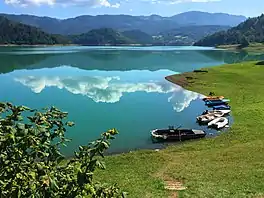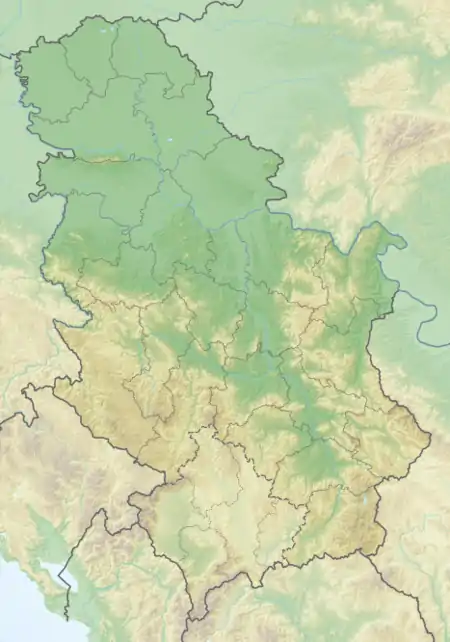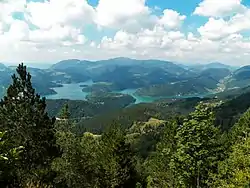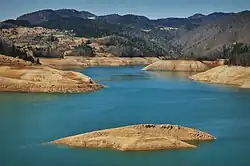| Zaovine Lake | |
|---|---|
 Panoramic view | |
 Zaovine Lake | |
| Location | Tara Mountain, Zlatibor District |
| Coordinates | 43°52′N 19°24′E / 43.87°N 19.40°E |
| Type | artificial |
| Primary inflows | Beli Rzav |
| Primary outflows | Beli Rzav |
| Basin countries | Serbia |
| Surface area | 15 km2 (5.8 sq mi) |
| Average depth | 80 m (260 ft) |
| Max. depth | 110 m (360 ft) |
| Water volume | 15 hm3 (12,000 acre⋅ft) |
| Surface elevation | 892 to 958 m (2,927 to 3,143 ft)[1] |
| Settlements | Zaovine |
Zaovine Lake (Serbian: Заовинско језеро, romanized: Zaovinsko jezero) is an artificial lake in central-west Serbia, on the Tara Mountain. It was created on the Beli Rzav river as a reservoir for the Bajina Bašta II reversible hydro power plant. The lake, with its five bays, have been nicknamed the "Jewel of Tara".[2]
Location
Zaovine Lake is located on the southern slopes of the Tara Mountain, in the direction of the Zvijezda mountain, which marks the border between Serbia and Bosnia and Herzegovina. It spreads out between the villages of Zaovine to the south-west and Mitrovac, major tourist resort on Tara, to the north-east.
Origin
Zaovine Lake was created between 1975 and 1983.[1] The Beli Rzav river, one of tributaries of the Rzav river, was dammed with a 125-metre (410 ft) high dam and an artificial lake was created as the reservoir for the Bajina Bašta II reversible hydroelectrical power plant (630 MW).[3] It is connected to the Drina river. Vežanje, the central hamlet of the village of Zaovine and which gave name to the lake, was flooded by the reservoir.[4]
Characteristics

The lake covers an area of 15 square kilometres (5.8 sq mi) and has five branches, or bays. When the Drina river has a high water level or during the rainy seasons, water from the Drina is pumped into the Zaovine Lake through an 8 kilometres (5.0 mi) pipeline. During converse conditions, water runs back from the Zaovine Lake into the Drina, producing electricity by turning the turbines inside the pipeline.[5] There are also five mini-lakes in the area (Spajića, Malo Zaovinsko, etc.) from which the water is also pumped into Zaovine Lake.[6] At full capacity, stored water in the Zaovine alone allows for the Bajina Bašta hydro to operate for 20 days.[2]
The road connecting Zaovine and Mitrovac bounds the northern side of the lake. The shores of the lake are seeing increasing numbers of visitors, fishermen and campers as summer houses are being built.
The maximum depth of the lake is 110 m (360 ft). The water is of such good quality, that it doesn't need the full industrial purification in order to be used for drinking.[1] The lake surface is known for the striking, blue color.[7]
In the immediate proximity of the lake the photovoltaic solar power plant "Brana Lazići" was built. Location, at an altitude of 880 m (2,890 ft), was chosen in 2014 when the conceptual design was also drafted. First 110 kWh became operational in 2016, with the remaining 220 kWh added in 2017, bringing the total installed capacity to 330 kWh. The plant has 1.152 solar panels which cover 5,700 m2 (61,000 sq ft).[8]
The lake is accessible from the directions of Kaluđerske Bare and Perućac, by the curvy roads through the surrounding conifer forests. The entire lake is encircled by the paved road, which connects all five bays. In the vicinity are also several scenic viewpoints, mountaineering paths, everglades and several preserved old wooden cabins (brvnare).[7]
2019 draining

In the early April 2019 numerous media reported about the massive draining of the lake. A large amount of water was drained from the reservoir in the period of 15 days. The Jelisavčići bay, 20 m (66 ft) deep at the normal water level, drained to the point that it could be walked over on foot. The entire lake was reduced to the stream, as the water level plunged for 40 m (130 ft).[2][9][10]
Complaints came from the local population, tourists, environmentalists, fishermen, excursionists and the representatives of the Tara National Park, who claimed that such fluctuation will damage wildlife, especially the fish population, as the lake is a spawning area. The empty lake became a national news, especially after the exposed, muddy banks triggered landslides down from the 300 m (980 ft) tall hills above the lake. Landslide area spread to 30 ha (74 acres), crumbling and tilting 21 houses and destroying roads, communal infrastructure, meadows and forests. The park authorities declared sections of the lake unsafe.[2][9][10][11]
Despite all the evidence to the contrary, the state-owned electric utility power company Elektroprivreda Srbije (EPS) maintained that they are not emptying the lake and that situation is normal.[2][11] After strong public and media reaction, the EPS began to pump water back into the lake.[9][10] However, this happened after similar abrupt draining of other large reservoirs, like the Vlasina Lake in the summer of 2018, Lake Zavoj in 2018 or the Uvac Lake in November 2018. These lakes are also in the protected areas and the EPS claimed that everything was normal, while the local population accused them of forcing the electricity production and selling it on the black market.[12][13] In the case of the Zaovine Lake, representative of the Tara National Park admitted that the "interest of the EPS differs from the interest of the park", while one of the local EPS managers stated that the "EPS commercial sector has to act according to the market".[10][11]
The EPS also claimed that the mass wasting area already existed and was prone to landsliding anyway. The area was known for the mass wasting, but it was dormant since before 2000, as the water level was stable. National park departments estimated that the damage, both the material and environmental, especially for the fish life in the lake, is major.[14]
Wildlife
The entire lake lies in the Tara National Park, one of five in Serbia. The lake is surrounded by vast woods as forestation of Tara mountain is 75%. Zaovine is the area where Josif Pančić, a leading Serbian botanist, discovered the endemic Serbian spruce in 1875 on the nearby Kik hill. The hill was destroyed in the early 1980s and material was used for building the dam that created Zaovine Lake. There are over 600 plant species in the area surrounding the lake, of which 15 are protected by law, including the Serbian spruce and edelweiss. Wildlife includes chamois.
There are 14 species of fish living in the lake, including nase, rainbow trout, European chub, Danube Roach, common barbel and European perch.[14]
In popular culture
The newly formed lake gained much publicity thanks to the Prophecy from Kremna. The book holds alleged prophecies of Miloš Tarabić (1809-54) and his nephew Mitar Tarabić (1829-99), villagers from Kremna, and one of the predictions said: "When Drina at Bajina Bašta gets bridged twice, and when it starts to flow up the Tara mountain, and the Good Friday and Đurđevdan fall on the same date, in those years some major trouble will occur".[7] However, in his Non-Prophecy from Kremna: A Study of Deception, in which he debunked the prophecies, Voja Antonić proved that this prophecy wasn't in any of the original papers, nor it he first modern edition which came before the dam was finished and lake created in 1983. Second edition, from 1984, also made no mention of it, before the prophecy appeared in the third edition, in 1986.[15]
Since then, the prediction of "Drina flowing up the Tara" became one of the most popularly accepted confirmation that the Tarabićs were truly clairvoyant. Even Antonić praised the "invention" of the editors for adding something recent into the book to "confirm" the prophecies, calling their intervention an "impressive hit".[15]
References
- 1 2 3 Miroslav Stefanović (14 October 2018). "Занимљива Србија: Перућац" [Interesting Serbia: Perućac]. Politika-Magazin, No. 1098 (in Serbian). pp. 19–21.
- 1 2 3 4 5 Branko Pejović (3 April 2019). "Dragulj Tare u blatu" [Tara's jewel in mud]. Politika (in Serbian). p. 20.
- ↑ Jovan Đ. Marković (1990). Enciklopedijski geografski leksikon Jugoslavije (in Serbo-Croatian). Sarajevo: Svjetlost. ISBN 86-01-02651-6.
- ↑ "Uživanju turisti, niču vikendice". Večernje Novosti (in Serbian). 2006-08-12. p. 30.
- ↑ Protection of natural values of Tara NP
- ↑ Jedno drugom do kolena
- 1 2 3 Branko Pejović (12 July 2020). Putevima Kostreš Harambaše [Paths of Kosta Harambaša]. Politika-Magazin, No. 1189 (in Serbian). pp. 20–21.
- ↑ Соларна електрана на Тари испуњава планове пориѕводње [Solar power plant on Tara works as planned]. Politika (in Serbian). 4 November 2019. p. 10.
- 1 2 3 "Klizište oko Zaovinskog jezera, urušilo se 20 kuća" [Landslide around the Zaovine Lake, 20 houses crumbled]. Politika (in Serbian). 5 April 2019.
- 1 2 3 4 Vesna Đurović (4 April 2019). "Ispuštanje vode iz jezera Zaovine pokrenulo klizišta, kuće i ljudi ugroženi" [Water draining from the Zaovine Lake triggered landslides, houses and population in danger] (in Serbian). N1.
- 1 2 3 Jelena Milutinović (4 April 2019). "Pad nivoa vode Zaovinskog jezera, kuće počele da se ruše" [Fall of the water level at Zaovine, houses began to crumble] (in Serbian). Al Jazeera.
- ↑ Branko Pejović (19 October 2018). "Da li je EPS ugrozio floru i faunu jezera Uvac" [Is EPS endangering the flaura and the fauna of the Lake Uvac]. Politika (in Serbian). p. 9.
- ↑ Danilo Kocić (4 October 2018). "EPS drastično spustio nivo Vlasinskog jezera" [EPS drastically lowered the water level in the Vlasina Lake]. Politika (in Serbian).
- 1 2 "Velika šteta od klizišta na obali Zaovinskog jezera" [Major damage because of the landslide on the shores of the Zaovine Lake]. Politika (in Serbian). 13 April 2019. p. 1 & 9.
- 1 2 Voja Antonić (2002). Kremansko neproročanstvo - Studija jedne obmane. Belgrade: Voja Antonić (self-published). pp. 79–80. ISBN 86-902159-2-1.